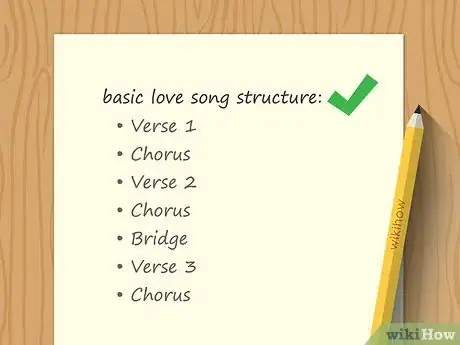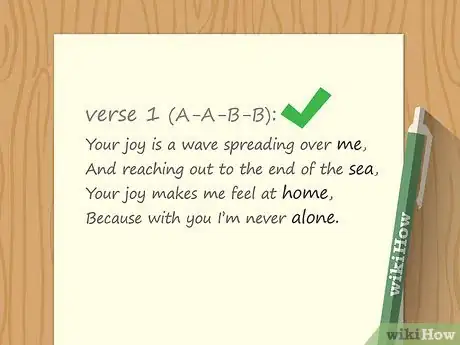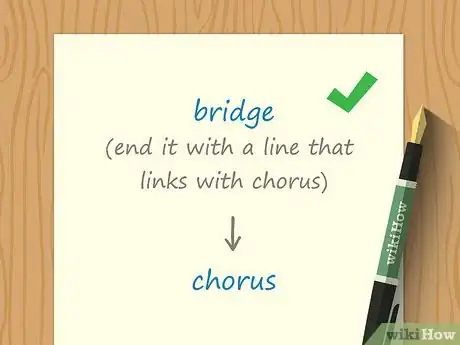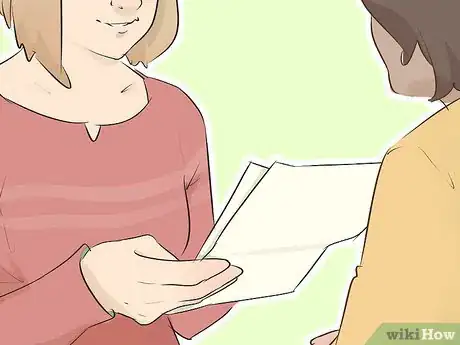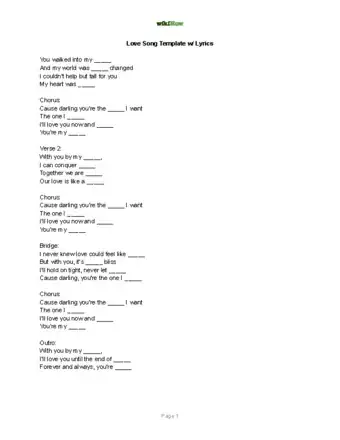This article was co-authored by Tanisha Hall and by wikiHow staff writer, Hunter Rising. Tanisha Hall is a Vocal Coach and the Founder and Executive Director of White Hall Arts Academy, Inc. an organization based in Los Angeles, California that offers a multi-level curriculum focused on fundamental skills, technique, composition, theory, artistry, and performance at a conservatory level. Ms. Hall's current and previous students include Galimatias, Sanai Victoria, Ant Clemons, and Paloma Ford. She earned a BA in Music from the Berklee College of Music in 1998 and was a recipient of the Music Business Management Achievement Award.
There are 13 references cited in this article, which can be found at the bottom of the page.
wikiHow marks an article as reader-approved once it receives enough positive feedback. This article has 11 testimonials from our readers, earning it our reader-approved status.
This article has been viewed 704,411 times.
Writing a love song is a great way to show how much another person means to you. When you start working on a love song, think about how the person makes you feel and use those feelings to write your lyrics. After coming up with your lyrics, all you need to do is set them to music and you’re ready to share it with your loved one!
Steps
Lyrics
-
1Outline the verses, choruses, and bridge to your song. Many songs, especially love songs follow a very similar pattern, containing 2-3 verses, 2-3 choruses, and a bridge. On a piece of paper, write the following structure for a basic love song: Verse 1 - Chorus - Verse 2 - Chorus - Bridge - Verse 3 - Chorus. Leave room between your headings to write your lyrics on your paper.[1]
- Verses usually consist of 4-6 long lines, or 8-10 short lines.
- Choruses are usually about 4-6 lines long.
- The bridge of a song is usually a 2 line section between the second chorus and the third verse or chorus.
EXPERT TIPHalle Payne has been writing songs since the age of eight. She has written hundreds of songs for guitar and piano, some of which are recorded and available on her Soundcloud or Youtube channel. Most recently, Halle was a part of a 15-person collaboration in Stockholm, Sweden, called the Skål Sisters.Singer/Songwriter
 Halle Payne
Halle Payne
Singer/SongwriterThink about how your experience with love is relatable. Halle Payne, Singer-Songwriter tells us: "You want your song to be about your own experiences, because that's what makes it personal and interesting. But, at the same time, if you can communicate some feeling in a way that people relate to it, you've got yourself a great love song. You want to ask yourself: 'How do I say something specific about my experience, that will also resonate with others?'"
-
2Pick a title for your song based on your loved one’s characteristics. Think about the person you’re writing the song for and make a list of some of the things you really love about them. Then, pick one of their characteristics that you want to expand on in your song and use it to influence your title. Keep your title between 1-4 words to keep it simple.[2]
- For example, if you want to write a song about how your loved one is a happy presence in your life, you may title the song “Joy” or “Happiness.”
- Whatever you choose for your title, make sure the rest of your lyrics match the theme.
Advertisement -
3Figure out the lyrics of your chorus first. Since your chorus is the most repeated section of your song, try to write it before any other part of your song.[3] Use simple words so your song is catchy and easy to sing along with. In your chorus, try to repeat the title of your song 2-3 times so your loved one will get the song stuck in their head. Plan out 4 lines using similes or metaphors to create imagery.[4]
- For example, if you want to write a song called “Joy,” you may use a chorus like: Your joy is a wave spreading over me, And reaching out to the end of the sea, Your joy makes me feel at home, Because with you I’m never alone
- You may either make the first two lines one rhyme and the last 2 lines a different rhyme, or you can alternate so line 1 rhymes with line 3, and line 2 rhymes with line 4.
EXPERT TIPYour chorus might just be you repeating one phrase over and over again; that's actually pretty standard across many genres.
Halle Payne has been writing songs since the age of eight. She has written hundreds of songs for guitar and piano, some of which are recorded and available on her Soundcloud or Youtube channel. Most recently, Halle was a part of a 15-person collaboration in Stockholm, Sweden, called the Skål Sisters.
Halle Payne
Singer/Songwriter Halle Payne
Halle Payne
Singer/Songwriter -
4Choose an alternating rhyme scheme for your verses. Verses are what tell the story throughout your song, so you can use them to expand on how you feel about your loved one. Use an A-B-A-B rhyme scheme so alternating lines end in the same sound. Pick a focus for each verse so you’re not repeating the same thing throughout the song.[5]
- For example, you may have the first verse talk about the past with your loved one while the second verse talks about the present or future.
- Try to include similes or metaphors that aren’t cliche to express how your loved one makes you feel.
- You don’t need to include a third verse in your song if you don’t want to.
Tip: Try using near rhymes, or slant rhymes, if you can’t find a word that fits perfectly. For example, you may rhyme “alone” with “home” since they have similar sounds.
-
5Make the lines in your bridge rhyme with one another. A bridge is a transition that presents or answers a question or further emphasizes the main point of your song. Your bridge gives the person listening to your song a break from the pattern of the chorus and verses. Continue talking about your theme during the bridge in a way you haven’t touched on yet.[6]
- If you’re going from your bridge right into your chorus, end it with a line that flows well into the chorus. For example, you may sing, “And when I’m with you, I feel…” to transition into the chorus, “Your joy…”
- If you want a longer bridge, repeat the 2 lines you’ve written.
Chords and Melodies
-
1Pick chords on a major key to make your song sound happy.[7] Choose a set of at least 4 chords to use in your love song. During each section of your song, play through the 4 chords in a different pattern. Make sure your chords aren’t in minor since it will make your love song sound sad.[8]
- For example, you may play C-F-G-F during your verse, but in your chorus, you may switch to A-F-C-G.
- Try using the E-flat Major, A Major, or B-flat Major for your love song since they have many cheerful notes.
- You can switch from a major to a minor key or vice versa in the bridge.
- If you don’t play an instrument, ask a friend or partner to help you bring your song to life.
-
2Play extra notes over the chords to add more interest to your song. If you want to add extra pitches and melodies to your instrumental, try playing notes in the chord or key you’re using in a different rhythm. Try out a few different note patterns to see what fits best with the song and how it sounds with the chords you’re playing.[9]
- This is done easily on a piano but may be more difficult to play on a guitar or other stringed instrument.
-
3Use notes from the chords for your vocal melody. Look at the notes you’re playing during your chord in the section of the song you’re trying to sing. Match the tone of your voice to one of the notes you’re playing so your singing is in tune with the instrumental you’re writing. As you work through your song, change the pitch of your voice to keep your lyrics from sounding monotonous.[10]
- Work your voice up to the note you’re trying to hit. Play the note you want to include in your melody and warm up your voice by starting on a low note. Continue to raise the pitch of your voice until you reach the pitch you want.
Tip: Put your highest note near the start of your chorus so anyone listening knows that it’s the beginning of a new part of your song and to make it catchier.
-
4Pick different rhythms for your vocal performance to keep your song interesting. If you keep the same vocal pattern throughout your whole song, it might sound boring. Hold different syllables in your lyrics for longer and shorter amounts of time to add different rhythms to your song.[11]
- Follow the same rhythm patterns in each of your verses so anyone listening can easily differentiate the parts of the song.
Sharing Your Song
-
1Show your song to another person to get their feedback. Before you settle on the song you’ve written, show a friend or someone else close to you to see what they think of it. Ask for any specific parts they liked or disliked or any lyrics that should be changed. Stay open to the criticism so you can present the best song to your loved one.[12]
- Only make the changes that you feel are necessary. If your friend makes a suggestion but it goes against what your heart is telling you, then don’t follow the advice.
-
2Record your song on a computer if you have recording software. Set up a microphone so you can easily play your song at a computer.[13] Use the microphone to record the instrumentals first and then record the vocals. Once the song is finished, you can adjust different volumes and export the audio to share online.[14]
- Don’t record your instrument and vocals at the same time since it will be harder to make adjustments.
- Use free programs like Audacity or Garageband for Mac to help record your song.
-
3Perform your song live for your loved one if you can. Try to find an opportunity to play your song for the person you wrote it for. Try looking for open mic nights at local cafes if you want to play it publicly, or just sit down at home and play it for them if you want a more personal moment.
- Make sure to practice your song before playing in front of other people since you may feel a little nervous.
Love Song Template with Lyrics
Community Q&A
-
QuestionWhat do you do when you have to sing the song to the person you love?
 Community AnswerBe brave and go ahead and sing it. You love this person, they'll love the effort you're making.
Community AnswerBe brave and go ahead and sing it. You love this person, they'll love the effort you're making. -
QuestionHow do I write a love song for my parents?
 Community AnswerJust say what you think of them. Choose descriptive words and phrases to show how they make you feel. You can try to include a specific moment that meant a lot to you.
Community AnswerJust say what you think of them. Choose descriptive words and phrases to show how they make you feel. You can try to include a specific moment that meant a lot to you. -
QuestionHow do I get the right melody when I'm done writing the lyrics?
 Community AnswerYou'll just know. Try singing the lyrics in a way that flows well to you, then tinker with it.
Community AnswerYou'll just know. Try singing the lyrics in a way that flows well to you, then tinker with it.
References
- ↑ http://www.songwriting.net/blog/bid/207339/Songwriting-Tip-Understanding-the-Most-Common-Song-Structures
- ↑ https://youtu.be/9G4zOiWr7Kw?t=123
- ↑ https://lyricworkroom.com/writing-chorus/
- ↑ https://youtu.be/J00nfGCYef4?t=273
- ↑ https://youtu.be/J00nfGCYef4?t=398
- ↑ https://youtu.be/J00nfGCYef4?t=615
- ↑ https://blog.landr.com/chord-progressions/
- ↑ https://www.wmich.edu/mus-theo/courses/keys.html
- ↑ https://youtu.be/0Uj90TYT1XU?t=95
About This Article
If you want to write a love song, start by outlining the song’s structure. Typically, love songs contain 2-3 verses, a chorus, and a bridge between the second and third verses, after the second chorus. For the chorus, which should be about 4 lines long, repeat the main idea of what you want to tell the person. In each verse, talk about something specific about the person, like a characteristic you love or the way they make you feel. Use the bridge as a way to switch up the flow of the song so it doesn’t get too repetitive. Read on to learn how to choose the chords and melodies for your love song!
